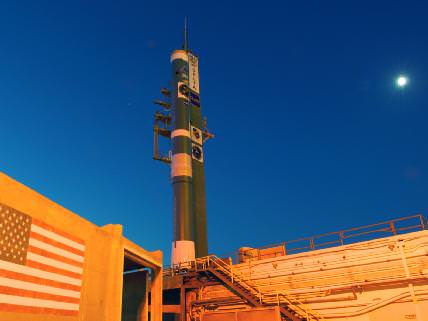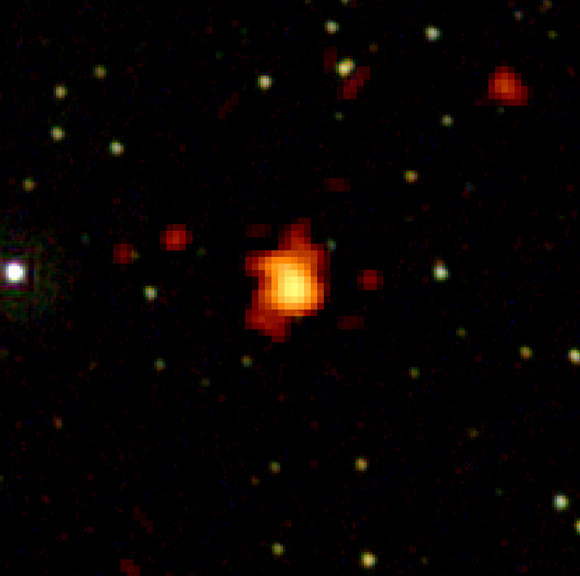GRB 080916C’s X-ray afterglow appears orange and yellow in this view that merges images from Swift’s UltraViolet/Optical and X-ray telescopes. Credit: NASA/Swift/Stefan Immler
The collapse of very massive stars can produce violent explosions, accompanied by strong bursts of gamma-ray light, which are some of the brightest events in the universe. Typical gamma-ray bursts emit photons with energies between 10 kiloelectron volts and about 1 megaelectron volt. Photons with energies above megaelectron volts have been seen in some very rare occasions but the distances to their sources were not known. An international research consortium is reporting in this week’s issue of the journal Science Express that the Fermi Gamma-Ray Space Telescope has detected photons with energies between 8 kiloelectron volts and 13 gigaelectron volts arriving from the gamma-ray burst 080916C.

The explosion, designated GRB 080916C, occurred just after midnight GMT on September 16 (7:13 p.m. on the 15th in the eastern US). Two of Fermi’s science instruments — the Large Area Telescope and the Gamma-ray Burst Monitor — simultaneously recorded the event. Together, the two instruments provide a view of the blast’s gamma-ray emission from energies ranging from 3,000 to more than 5 billion times that of visible light.
A team led by Jochen Greiner at the Max Planck Institute for Extraterrestrial Physics in Garching, Germany, established that the blast occurred 12.2 billion light-years away using the Gamma-Ray Burst Optical/Near-Infrared Detector (GROND) on the 2.2-meter (7.2-foot) telescope at the European Southern Observatory in La Silla, Chile.
“Already, this was an exciting burst,” says Julie McEnery, a Fermi deputy project scientist at NASA’s Goddard Space Flight Center in Greenbelt, Maryland. “But with the GROND team’s distance, it went from exciting to extraordinary.”
Astronomers believe most gamma-ray explosions occur when exotic massive stars run out of nuclear fuel. As a star’s core collapses into a black hole, jets of material — powered by processes not yet fully understood — blast outward at nearly the speed of light. The jets bore all the way through the collapsing star and continue into space, where they interact with gas previously shed by the star. This generates bright afterglows that fade with time.
The burst is not only spectacular but also enigmatic: a curious time delay separates its highest-energy emissions from its lowest. Such a time lag has been seen clearly in only one earlier burst, and researchers have several explanations for why it may exist. It is possible that the delays could be explained by the structure of this environment, with the low- and high-energy gamma rays “coming from different parts of the jet or created through a different mechanism,” said Large Area Telescope Principal Investigator Peter Michelson, a Stanford University physics professor affiliated with the Department of Energy.
Another, far more speculative theory suggests that perhaps time lags result not from anything in the environment around the black hole, but from the gamma rays’ long journey from the black hole to our telescopes. If the theorized idea of quantum gravity is correct, then at its smallest scale space is not a smooth medium but a tumultuous, boiling froth of “quantum foam.” Lower-energy (and thus lighter) gamma rays would travel faster through this foam than higher-energy (and thus heavier) gamma rays. Over the course of 12.2 billion light years, this very small effect could add up to a significant delay.
The Fermi results provide the strongest test to date of the speed of light’s consistency at these extreme energies. As Fermi observes more gamma-ray bursts, researchers can look for time lags that vary with respect to the bursts. If the quantum gravity effect is present, time lags should vary in relation to the distance. If the environment around the burst origin is the cause, the lag should stay relatively constant no matter how far away the burst occurred.
“This one burst raises all sorts of questions,” Michelson says. “In a few years, we’ll have a fairly good sample of bursts, and may have some answers.”
Source: Eurekalert


Geeeezzz, I assume should an event happen in ‘near by’ galaxy M33 and ‘beamed’ our
way, 99.994% of our current species gone(formet humans!!) that.006 will somehow escape extermination. Where did I get such a figure, an old soap commerical. I am not an expert on these matters, the figure is difficult to comprehend but know something will still survive.
Awesome power- I hope the militaries of the world don’t do research on how to mimic this beast of a blast, anyway, where will they test
a ‘taste’ of this power=blowing up Jupiter Lol.
Very nice result!
*waits for Science to appear*
One correction: “Photons with energies above megaelectron volts have been seen in some very rare occasions but the distances to their sources were not known.”
This should be gigaelectronvolts. Detections up to 10 MeV have happened often enough, including for quite a few GRBs which have exact spectroscopic redshifts.
Having read other articles on super GRB, this event strikes me as something awesome!!. Don Alexander making a correction to the power of this event makes it even more amazing.
Should this be ‘beamed’ our way from relatively closeby, humans will have a bad day, a true 100% human exterminator!!!!.
After say a few hundred million years after this event wipes out most Earth life and life gets to the stage of advanced lifeforms
again, I wonder what will be the most advanced and what it will be thinking about!??
What a fascinating observation by Fermi. I always like discoveries that raise more questions than answers, since these events are usually trying to tell us something deep( i.e. Hanny’s Voorwerp and the recently discovered UV dwarf galaxies in the Leo Ring ). I’m curious if any air shower arrays may have also imaged this event since even more energetic radiation and-or neutrally charged particles may also have been produced.
Very nice. Fermi just paid for itself.
@Jon: Haven’t heard anything about that, alas.
One problem is that Fermi LAT positions (which are precise enough to allow ground-based follow-up) are still a long-time coming. The GBM positions are very large (usually several degrees) and, so far, quite WRONG even. (Just two days ago, there was another quite bright GRB detected by LAT and GBM, and the GBM position was off by many degrees… 🙁 )
Therefore, Fermi is not yet useful for rapid follow-up from any narrow-field ground-based observatories.
“Lower-energy (and thus lighter) gamma rays would travel faster through this foam than higher-energy (and thus heavier) gamma rays”
Photons with weight/mass?
“Over the course of 12.2 billion light years, this very small effect could add up to a significant delay.”
Are we back to “tired light”?
Somebody out there got their own LHC working – for a brief moment – I see.
12 Billion LY??. I’m having trouble with this. Thats over 12 Billion years ago – early universe… I’d expect the ‘picture’ of this event would never get larger than a dot, not an expanding sphere. Am I way off on this??
@Ignoramus: Photons have zero rest mass, but do carry momentum; as such, higher energy photons could be considered ‘more massive’.
Also, ‘tired light’ theories were about redshift, not time-delay. The idea here is that space may be a medium with a slight refractive index which, like most refractive materials, slows energetic photons more than less-energetic ones.
@Timmy
I was abt to post the same!! 🙂 🙂
That we have a working LHC out there!!!
At 12 Billion LY the actual event would be a dot with this instrument, but not knowing more details i wouldnt rule out instrumental side-effects. Very bright objects often show the ‘dim’ flaws in the construction/technology involved, but i dont know why this object is shown extended. Perhaps some completely different reason.
I read (I forget where) that a GRB happens about every 100,000 years in a galaxy (does that sound right? can anyone verify?). Thankfully we weren’t in the crosshairs of this one. It would have been a very bad day without SPF 10 to the 234th power. A question I have about GRB’s that maybe someone here could answer is: If a GRB like this occured in the Milky Way, and we weren’t in a direct line of fire, what would happen? would it be daylight at night time? I have limited knowledge of this and I know that there are some very well-versed people here, so help me out.
/me dons tinfoil hat in the hope of avoiding the GRB radiation.
Meanwhile I shall continue my wait for Eta Carinae to complete its cycle of death in bright and glorious fasion, content in the knowledge that it’s expelled gases are not pointing directly towards us.
What if the burst was actually a double GMB as in a binary system; one low energy resulting in a neutron star followed shortly after (perhaps even influencing) the high energy burst resulting in a black hole.
Fishing w/o bait again.
Vino – they DID have a working LHC out there.
:^)
Not to be persistent but, the image seems to show a large bright circular object with what could be the beginnings of the polar jets at about 1 o’clock and 7 o’clock, then there’s this odd, not so bright bump at about 10 o’clock. That’s what brought to mind a double event in close proximity; one small, one large.
I’ll go away now.
I forgot to mention the bump (or protrusion) also has what looks like a jet of its own shooting off to the left of it.
I lied, now I’ll go away (maybe) lol.
I wonder if there was/will be any studies done if any progenitor super massive star is found to be150x mass of Sun,collapses into a black hole with the energy of this beast- how much X-Sun mass it will require to convert each to gamma-rays,x-rays, neutrinos-to convert say 20x mass of Sun quickly into gamma-rays, will it be enough to have the energy of this beast?. (I’m hopeing such a progenitor star is relatively close, perhaps 50-100M LY aways) It would be interesting.
Crap: Another civilization torched when they finally got their Large Hadren Collider up to full steam;)
Okay, people, reread the comments in this thread – we’ve had three LHC jokes already.
Time to come up with something else that wipes out an entire planet now.